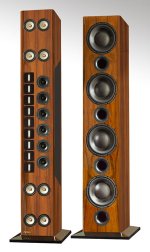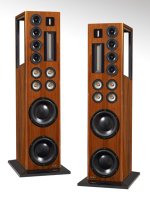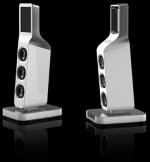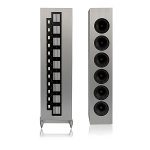- Thread Author
- #1
For:
Kevin in Wappinger Falls New York (wherever that is) asked me an interesting question recently.
“Arnie Nudell popularized the line source loudspeaker design and many of his most revered speakers such as the Quantum Line Source, the IRS 1B, the IRS V, and the Genesis 1 (and apparently at least the two larger members of your forthcoming AN series loudspeakers) are all line source designs. Why don’t we see more line source loudspeaker designs? Is it strictly due to the cost because of the many more drivers, the larger cabinet, the increased manufacturing labor cost – or are there other attributes that have made them less popular?”
This is a really good question and one we don’t talk about much. Perhaps it’s a good idea to first get on the same page. The classic two-way or three-way loudspeaker has two or three drivers in a box. The multiplicity of drivers—tweeter, midrange, woofer—is needed to break apart the frequencies so each driver only has to handle a specific range: tweeters handle the higher frequencies about 2kHz and the woofer handles everything from that point down.
A line source handles the frequency divisions in exactly the same way—tweeters, midrange, and woofers—but instead of relying upon a single driver for each range multiple drivers are instead employed, typically with a line of many tweeters and sometimes many midranges. The advantages of multiple drivers in a line are manifold: each driver has fewer demands and the waveform comes out in a long, vertical, cylinder rather than a single driver’s ever-expanding circular wave.
The advantages of a line source vs. a point source can be summed up fairly easily. A point source sound radiates in all directions from the driver and quickly loses energy as it floods the room in a 180˚ plane. Worse, this expanded radiation pattern hits the ceiling, walls, and floor and reflects back into the room out of synch (time) with the initial launch. Only those listeners in a narrow sweet spot get to enjoy the best sound. A line source radiates a more focused pattern in the shape of a tall vertical cylinder that, above about 500Hz, has nearly no floor, ceiling, or sidewall reflections to dissipate energy and add to sonic confusion.
All that said, tomorrow we’ll look at some older Infinity designs.
Source: https://www.psaudio.com/pauls-posts/line-sources/
Against:
"A lot of tosh is written about line sources, particularly in praise of full-height lines which reach from floor to ceiling and - if the floor and ceiling are reflective, behaving as acoustic mirrors - approximate the behavior of an infinite line source. What the careless proponents of full-height line sources fail to appreciate is that - because listening takes place in the nearfield - the frequency response at the listening position is not flat. Time delays from different sections of the line cause frequency dependent destructive interference resulting in a frequency response that declines from low frequencies to high frequencies at 3db per octave (10db per decade).
This can be equalized, potentially, but it means that the speaker input at 20khz has to be 30db higher than at 20hz for the same acoustic output. In power terms 30 db is equivalent to a ratio of 1000:1, so 1kw input would be required at 20khz to match acoustic output from just 1w input at 20hz.
Shorter line sources behave better in that the start of the 3db per octave roll-off is postponed to higher frequencies at practical listening distances, but the frequency response now varies with distance from the line.
Fig 2 illustrates this for a 1m high continuous line source, showing the theoretical frequency responses at 1m (blue), 3m (red) and 5m (green) on the axis of the line center. As well as these responses being distance-dependent, they have pronounced ripples around the 3db per octave roll-off. The message is that is pays to keep line sources as short as possible, which in the context of achieving a given peak output capability suggests using as many drivers as necessary but no more.
Vertical line sources disposed side-by-side (a la IRS) also introduce off-axis response issues in the horizontal plane through crossover - another unwelcome consequence of this approach and an effect which the vertical disposition of drivers in most conventional speakers is specifically adopted to avoid."
Source: Keith Howard, HiFi News, May 2018 (page 29-31).
Kevin in Wappinger Falls New York (wherever that is) asked me an interesting question recently.
“Arnie Nudell popularized the line source loudspeaker design and many of his most revered speakers such as the Quantum Line Source, the IRS 1B, the IRS V, and the Genesis 1 (and apparently at least the two larger members of your forthcoming AN series loudspeakers) are all line source designs. Why don’t we see more line source loudspeaker designs? Is it strictly due to the cost because of the many more drivers, the larger cabinet, the increased manufacturing labor cost – or are there other attributes that have made them less popular?”
This is a really good question and one we don’t talk about much. Perhaps it’s a good idea to first get on the same page. The classic two-way or three-way loudspeaker has two or three drivers in a box. The multiplicity of drivers—tweeter, midrange, woofer—is needed to break apart the frequencies so each driver only has to handle a specific range: tweeters handle the higher frequencies about 2kHz and the woofer handles everything from that point down.
A line source handles the frequency divisions in exactly the same way—tweeters, midrange, and woofers—but instead of relying upon a single driver for each range multiple drivers are instead employed, typically with a line of many tweeters and sometimes many midranges. The advantages of multiple drivers in a line are manifold: each driver has fewer demands and the waveform comes out in a long, vertical, cylinder rather than a single driver’s ever-expanding circular wave.
The advantages of a line source vs. a point source can be summed up fairly easily. A point source sound radiates in all directions from the driver and quickly loses energy as it floods the room in a 180˚ plane. Worse, this expanded radiation pattern hits the ceiling, walls, and floor and reflects back into the room out of synch (time) with the initial launch. Only those listeners in a narrow sweet spot get to enjoy the best sound. A line source radiates a more focused pattern in the shape of a tall vertical cylinder that, above about 500Hz, has nearly no floor, ceiling, or sidewall reflections to dissipate energy and add to sonic confusion.
All that said, tomorrow we’ll look at some older Infinity designs.
Source: https://www.psaudio.com/pauls-posts/line-sources/
Against:
"A lot of tosh is written about line sources, particularly in praise of full-height lines which reach from floor to ceiling and - if the floor and ceiling are reflective, behaving as acoustic mirrors - approximate the behavior of an infinite line source. What the careless proponents of full-height line sources fail to appreciate is that - because listening takes place in the nearfield - the frequency response at the listening position is not flat. Time delays from different sections of the line cause frequency dependent destructive interference resulting in a frequency response that declines from low frequencies to high frequencies at 3db per octave (10db per decade).
This can be equalized, potentially, but it means that the speaker input at 20khz has to be 30db higher than at 20hz for the same acoustic output. In power terms 30 db is equivalent to a ratio of 1000:1, so 1kw input would be required at 20khz to match acoustic output from just 1w input at 20hz.
Shorter line sources behave better in that the start of the 3db per octave roll-off is postponed to higher frequencies at practical listening distances, but the frequency response now varies with distance from the line.
Fig 2 illustrates this for a 1m high continuous line source, showing the theoretical frequency responses at 1m (blue), 3m (red) and 5m (green) on the axis of the line center. As well as these responses being distance-dependent, they have pronounced ripples around the 3db per octave roll-off. The message is that is pays to keep line sources as short as possible, which in the context of achieving a given peak output capability suggests using as many drivers as necessary but no more.
Vertical line sources disposed side-by-side (a la IRS) also introduce off-axis response issues in the horizontal plane through crossover - another unwelcome consequence of this approach and an effect which the vertical disposition of drivers in most conventional speakers is specifically adopted to avoid."
Source: Keith Howard, HiFi News, May 2018 (page 29-31).





